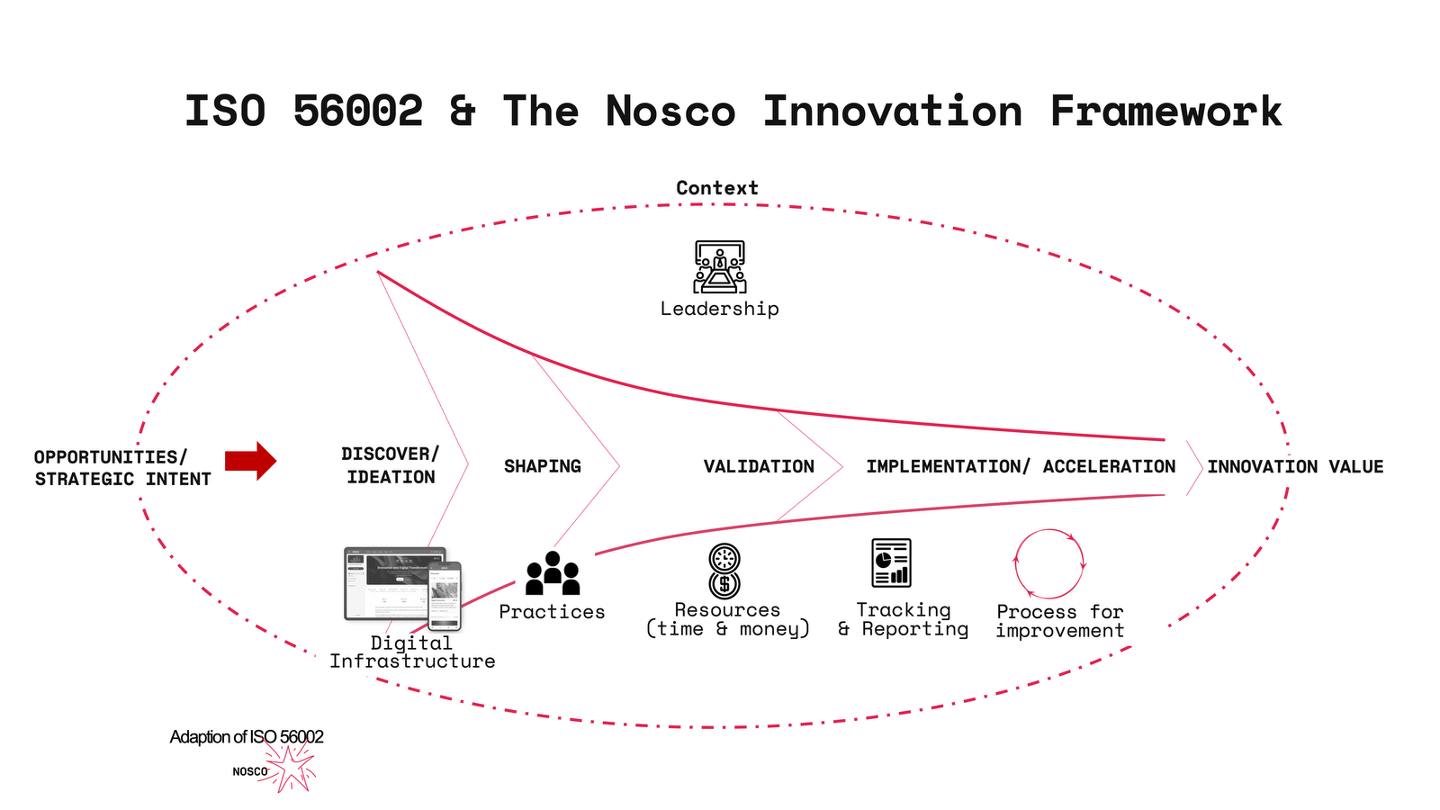
Aligning Promise and Practice – Using the ISO 56002 Innovation leadership framework
Most companies talk about innovation, but few achieve it systematically. ISO 56002 provides the framework to transform innovation from aspiration into structured business impact. Here’s how organizations can bridge the gap between “what we say we do” and “what we actually do.”
The Core Idea Behind Industry Standards
The core idea behind any industry standard is that it serves as a measuring stick to determine whether “what we say we do” aligns with “what we actually do.” It provides a quality stamp and an evidence-based evaluation tool that creates the necessary framework for improvement, supporting innovation efforts and ultimately improving business impact.
Nowhere is this more critical than in corporate innovation, where research shows that 83% of companies rank innovation among their top three priorities, yet only 3% consider themselves truly “Innovation Ready.” This gap between intention and implementation is precisely where ISO 56002 can be transformative.
This article is aimed at innovation managers, chief innovation officers, and executives seeking a structured approach to improving the outcomes of their innovation efforts.
As discussed in our first article, “ISO 56002 standard – an Oxymoron, a Help, or a Bureaucratic Nightmare?” (to read it, click here), innovation and standards may seem conflicting, but they are not. Innovation needs structure to thrive. The standard and its assessment system provide that structure and a systematic approach to transforming innovation into a strategic business function.
The innovation team can use the framework to engage with the executive team by presenting an assessment of the current level, identifying gaps, and offering recommendations. It can also be used externally to demonstrate the correlation between “what we say we do” and “what we actually do.”
Why Innovation Assessment Matters: The Strategic Imperative
Innovation is not optional; it is a core driver of modern business success.
The Draghi report concludes that Europe is falling further behind in global competitiveness, especially compared to the United States and China, and that urgent, coordinated action is needed to address this gap. The report highlights chronic low economic growth, a widening innovation gap, and structural barriers that hinder the scale-up and commercialization of innovative companies.
Numerous reports have documented the need for companies and organizations to update their innovation operating models and measure the impact of their innovation efforts. An Innovation Management System (IMS), guided and assessed by the ISO 56001 and ISO 56002 frameworks, offers a structured and holistic approach to transform creative efforts into systematic, strategic assets that deliver measurable results.
ISO provides an overarching management system that is internationally recognized and approved, helping to ensure quality, drive improvements, and increase the likelihood of delivering meaningful impact. ISO 56002 can be integrated into an organization’s overall management and leadership structure.
The Framework: Seven Dimensions of Innovation Excellence
True value emerges when organizations move from words to action through a comprehensive assessment framework. We have adapted the innovation model with the Nosco framework so that it is fully aligned with ISO 56002, integrating all seven key dimensions of an effective IMS:
1. Context of the Organization
The company must analyze how both internal and external factors impact innovation, ensuring activities are strategically relevant and aligned with competitive pressures. This includes market trends, technological developments, internal capabilities, and stakeholder expectations.
This analysis should be translated into practical guidance:
-
What to search for
-
Where to play
-
How to focus innovation efforts
We refer to these as innovation strategy, search fields, and opportunity spaces. They guide ideation and help populate innovation pipelines with relevant ideas.
2. Leadership: The Foundation of Innovation Culture
Vision and strategy must be translated into innovation search fields and opportunity spaces. Leadership requires future-focused thinking and clear strategic direction, including:
-
Meetings that prioritize ideas and allocate resources (time and money)
-
Clearly defined roles for leadership and management
-
Regular executive attention devoted to “tomorrow’s business,” not just today’s operations
3. Planning: Strategic Innovation Portfolio Management
A structured process ensures innovation initiatives align with organizational goals. This includes:
-
Portfolio management with balanced approaches for time and risk
-
Clear evaluation criteria for all ideas
-
Defined objectives for each stage with ROI and impact measurement
-
Structured processes for ideation, shaping, validation, and acceleration
4. Support Structures: Enabling Innovation Success
A robust support system goes beyond resources—it includes transparent digital infrastructure to connect and empower the innovation process.
Key elements include:
-
Centralized digital platforms (e.g., Nosco) for idea submission, tracking, evaluation, and advancement
-
Transparency on progress and executive engagement in reviews
-
Access to best-in-class tools and methods at every stage
-
Systematic capability building through programs such as “License to Innovate”
This ensures consistency, quality, and a culture of continuous learning.
5. Operations: Excellence in Innovation Execution
Execution focuses on implementing projects using best practices, tools, and methods—from idea generation through commercialization.
A systematic framework allows for learnings, improvements, and efficient lifecycle management of innovation projects.
6. Performance Evaluation: Evidence-Based Innovation Management
Audit and feedback processes ensure claimed impact is measured when ideas or projects go live. Regular evaluation enables:
-
Tracking progress
-
Identifying improvement areas
-
Making data-driven adjustments to optimize the IMS
7. Continuous Improvement: Dynamic Innovation Evolution
An effective IMS incorporates feedback, lessons, and new insights for ongoing improvement. This includes:
-
Performance metrics (time-to-market, ROI, customer satisfaction)
-
Feedback mechanisms from stakeholders
-
A culture of learning from failures
-
Agility to adapt to shifts in technology and markets
-
Knowledge management systems to capture and share insights

Leadership Assessment: Where Transformation Begins
As with many business practices, effective innovation starts at the top. Leadership must actively engage and dedicate time to “tomorrow’s business.” Without this, results become inconsistent and unsustainable.
Challenges include:
-
Difficulty in finding good ideas without direction
-
Lack of transparent resource allocation, leading to random outcomes
Criteria for “the best” ideas should be clear—supported by market demand, company capabilities, and strategic value.
Examples of Innovation Assessment Outcomes
-
Time allocation: An assessment revealed executives dedicated little time to “tomorrow’s business.” The solution: quarterly meetings focused solely on innovation, prepared by the innovation team and led by the CEO.
-
Zombie projects: Several projects lacked sponsor attention for months. After review, 30% gained new momentum while the rest were closed.
-
Resource dedication: Leading organizations dedicate budgets and FTEs specifically to innovation, ensuring measurable commitment.
-
Systematic improvement: Regular innovation assessments correlate with higher innovation culture scores, stronger engagement, and higher growth rates.
Conclusion: Innovation as Sustained Competitive Advantage
ISO 56002 transforms innovation from aspiration into strategic action by embedding systematic innovation management into leadership behaviors and daily routines.
-
Step 1: Assess the current state of your IMS.
-
Step 2: Establish regular assessments to drive continuous improvement.
The standard provides a clear pathway to close the gap between “what we say we do” and “what we actually do.” It inspires leaders to champion a culture of learning and evidence-based exploratory work.
The evidence is compelling: organizations that implement structured IMS demonstrate enhanced innovation capabilities, improved efficiency, and stronger stakeholder trust. They achieve faster time-to-market, higher returns on innovation investment, and resilient competitive advantages.
In today’s competitive landscape—where Europe risks falling behind—ISO 56002 offers a proven framework for sustainable renewal and systematic capability building. An Innovation Management System provides the structure to ensure that innovation becomes a strategic asset, actively shaping the future rather than just reacting to change.

Morten has more than 20 years of experience as a management consultant, helping Implement Consulting Group grow to the largest independent consultancy in Scandinavia. An entrepreneur at heart, he has started and grown several successful businesses and now serves as a board member to numerous start-ups.
MORE ARTICLES





